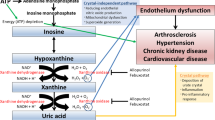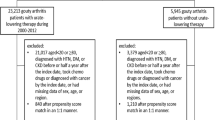Abstract
Therapy with losartan compared to irbesartan was performed in a Chinese sample of hypertensive patients with elevated serum uric acid (SUA) levels. After 1 week of screening and a 2 week single-blinded placebo baseline period, patients were treated for 4 weeks with losartan 50 mg or irbesartan 150 mg. After 4 weeks, patients with SiDBP<90 mmHg and SiSBP<140 mmHg continued the same dose regimen for another 4 weeks. If blood pressure was not controlled after 4 weeks of treatment, the dose of either regimen was doubled to losartan 100 mg and irbesartan 300 mg. There were 351 patients randomized (176 to losartan and 175 to irbesartan), and of these, 325 patients completed the study (162 in the losartan group and 163 in the irbesartan group). At baseline, the median SUA level in the losartan group was 422 and 420 μmol/l in the irbesartan group. At 8 weeks of therapy, SUA decreased by 63 μmol/l in the losartan group compared to 12 μmol/l in the irbesartan group (P<0.0001). Blood pressure declined comparably in both groups from 151/92 mmHg at baseline to 137/83 and 135/83 (losartan and irbesartan, respectively, NS). No severe AEs were found for either treatment group. Therapy with losartan decreased SUA levels significantly more than irbesartan in Chinese patients with hypertension and elevated SUA levels, demonstrating the unique uricosuric effect of this ARB in this ethnic group.
This is a preview of subscription content, access via your institution
Access options
Subscribe to this journal
Receive 12 digital issues and online access to articles
$119.00 per year
only $9.92 per issue
Buy this article
- Purchase on Springer Link
- Instant access to full article PDF
Prices may be subject to local taxes which are calculated during checkout




Similar content being viewed by others
References
Johnson RJ, Kang DH, Feig D, Kivlighn S, Kanellis J, Watanabe S et al. Is there a pathogenetic role for uric acid in hypertension and cardiovascular and renal disease? Hypertension 2003; 41(6): 1183–1190.
Wurzner G, Gester J-C, Chiolero A, Maillard M, Fallab-Stubi C-L, Brunner HR et al. Comparative effects of losartan and irbesartan on serum uric acid in hypertensive patients with hyperuricaemia and gout. J Hypertens 2001; 19(10): 1855–1860.
Johnson RJ . Uric acid and diet – insights into the epidemic of cardiovascular disease. New Engl J Med 2004; 350: 1071–1073.
Hoieggen A, Alderman MH, Kjeldsen SE, Julius S, Devereux RB, de Faire U et al. The impact of serum uric acid on cardiovascular outcomes in the LIFE study. Kidney Int 2004; 65: 1041–1049.
Choi H . Purine-rich foods, dairy and protein intake, and the risk of gout in men. New Engl J Med 2004; 350: 1093–1103.
Weir CJ, Muir SW, Walters MR, Lees KR . Serum urate as an independent predictor of poor outcome and future vascular events after acute stroke. Stroke 2003; 34(8): 1951–1956.
Puig JG, Ruilope LM . Uric acid as a cardiovascular risk factor in arterial hypertension. J Hypertens 1999; 17(7): 869–872.
Fang Qi . Modern Clinical Practice-Uric Acid and Gout. People's Medical Officer Press: Beijing, 1995, pp. 2868–2878.
Nakashima M, Uematsu T, Kosuge K, Kanamaru M . Pilot study of the uricosuric effect of DuP-753, a new angiotensin II receptor antagonist, in healthy subjects. Eur J Clin Pharmacol 1992; 42(3): 333–335.
Sweet CS, Bradstreet DC, Berman RS, Jallard N, Saenz A, Weidler DJ . Pharmacodynamic activity of intravenous E-3174, an angiotensin II antagonist, in patients with essential hypertension. Am J Hypertens 1994; 7(12): 1035–1040.
Takahashi S, Moriwaki Y, Yamamoto T, Tsutsumi Z, Ka T, Fukuchi M . Effects of combination treatment using anti-hyperuricaemic agents with fenofibrate and/or losartan on uric acid metabolism. Ann Rheum Dis 2004; 62(6): 572–575.
Hamada T, Hisatome I, Kinugasa Y, Matsubara K, Shimizu H, Tanaka H et al. Effect of the angiotensin II receptor antagonist losartan on uric acid and oxypurine metabolism in healthy subjects. Intern Med 2002; 41(10): 793–797.
Puig JG, Mateos F, Buno A, Ortega R, Rodriguez F, Dal Re R . Effect of eprosartan and losartan on uric acid metabolism in patients with essential hypertension. J Hypertens 1999; 17(7): 1033–1039.
Ruilope LM, Simpson RL, Toh J, Arcuri KE, Goldberg AI, Sweet CS . Controlled trial of losartan given concomitantly with different doses of hydrochlorothiazide in hypertensive patients. Blood Press 1996; 5(1): 32–40.
Acknowledgements
This study was supported by the grant of Merck Medical School.
Author information
Authors and Affiliations
Corresponding author
Rights and permissions
About this article
Cite this article
Dang, A., Zhang, Y., Liu, G. et al. Effects of losartan and irbesartan on serum uric acid in hypertensive patients with hyperuricaemia in Chinese population. J Hum Hypertens 20, 45–50 (2006). https://doi.org/10.1038/sj.jhh.1001941
Received:
Revised:
Accepted:
Published:
Issue Date:
DOI: https://doi.org/10.1038/sj.jhh.1001941
Keywords
This article is cited by
-
Effects of losartan and enalapril on serum uric acid and GFR in children with proteinuria
Pediatric Nephrology (2021)
-
Autosomal dominant tubulointerstitial kidney disease: diagnosis, classification, and management—A KDIGO consensus report
Kidney International (2015)
-
Serum uric acid level in primary hypertension among Chinese nonagenarians/centenarians
Journal of Human Hypertension (2009)



